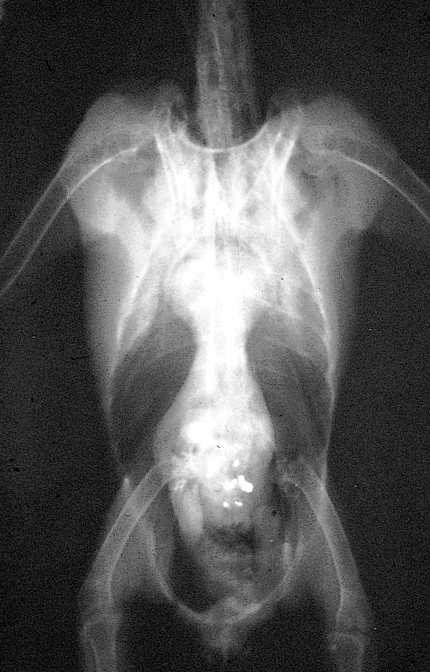Difference between revisions of "Avian Medicine Q&A 25"
(Created page with "<br style="clear:both;" /> {| align="left" width="100%" style="background-color:#04B4AE" |- | align="center" | 90px|Mansonlogo | align="left" | This ques...") |
|||
| (One intermediate revision by the same user not shown) | |||
| Line 3: | Line 3: | ||
|- | |- | ||
| align="center" | [[File:Manson_logo.gif|90px|Mansonlogo]] | | align="center" | [[File:Manson_logo.gif|90px|Mansonlogo]] | ||
| − | | align="left" | This question was provided by [[:Category:Manson|Manson Publishing]] as part of the [[OVAL Project]]. See more [[ | + | | align="left" | This question was provided by [[:Category:Manson|Manson Publishing]] as part of the [[OVAL Project]]. See more [[Category: Avian Medicine Q&A|Avian Medicine questions]] |
|} | |} | ||
<br><br><br> | <br><br><br> | ||
| Line 22: | Line 22: | ||
In an acute case, the clinical signs classically occur within 48 hours of ingestion – these may include depression, lethargy, weakness, anorexia, regurgitation (which develops into severe vomiting), polyuria and diarrhoea. The faeces may be extremely green or contain large amounts of blood. In addition, any disorders of the CNS – tremors; ataxia; even blindness – may be seen. | In an acute case, the clinical signs classically occur within 48 hours of ingestion – these may include depression, lethargy, weakness, anorexia, regurgitation (which develops into severe vomiting), polyuria and diarrhoea. The faeces may be extremely green or contain large amounts of blood. In addition, any disorders of the CNS – tremors; ataxia; even blindness – may be seen. | ||
| − | |l2= Lead Poisoning | + | |l2= Lead Poisoning |
|q3= What are the commonest errors that may result in a clinician failing to make the correct diagnosis? | |q3= What are the commonest errors that may result in a clinician failing to make the correct diagnosis? | ||
|a3= Failure to radiograph such a case is a common error. | |a3= Failure to radiograph such a case is a common error. | ||
A bird presenting with any of these signs should always be radiographed even if the owner insists that the bird could not have ingested lead. Another error would be the misinterpretation of poor quality radiographs. Ventricular heavy metal fragments must not be mistaken for grit. | A bird presenting with any of these signs should always be radiographed even if the owner insists that the bird could not have ingested lead. Another error would be the misinterpretation of poor quality radiographs. Ventricular heavy metal fragments must not be mistaken for grit. | ||
| − | |l3= | + | |l3= |
</FlashCard> | </FlashCard> | ||
Revision as of 15:43, 29 June 2011
| This question was provided by Manson Publishing as part of the OVAL Project. See more |
This Amazon parrot presented with acute diarrhoea and disturbance of balance.
| Question | Answer | Article | |
| What is your diagnosis from this radiograph? | There are metal particles detectable in the digestive tract.
In the majority of cases these are lead, which causes typical signs of heavy metal toxicity. Zinc particles are also common, especially when birds are housed in new galvanized cages or old ones that have been soldered. |
Link to Article | |
| What clinical signs would be expected? | In companion birds, one most often sees an acute course in lead intoxication.
In freeranging birds, chronically diseased individuals are most frequently seen by the veterinarian. In an acute case, the clinical signs classically occur within 48 hours of ingestion – these may include depression, lethargy, weakness, anorexia, regurgitation (which develops into severe vomiting), polyuria and diarrhoea. The faeces may be extremely green or contain large amounts of blood. In addition, any disorders of the CNS – tremors; ataxia; even blindness – may be seen. |
Link to Article | |
| What are the commonest errors that may result in a clinician failing to make the correct diagnosis? | Failure to radiograph such a case is a common error.
A bird presenting with any of these signs should always be radiographed even if the owner insists that the bird could not have ingested lead. Another error would be the misinterpretation of poor quality radiographs. Ventricular heavy metal fragments must not be mistaken for grit. |
[[|Link to Article]] | |
